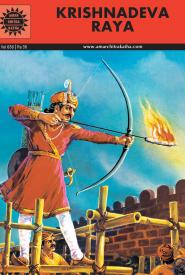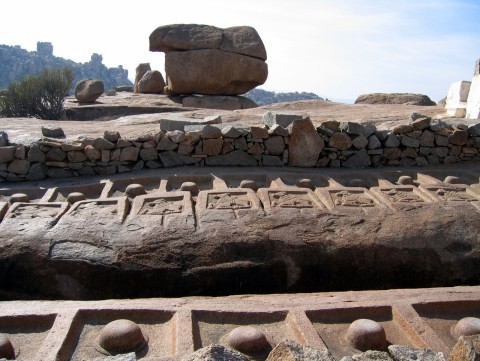The year is 1509. The ailing ruler of Vijayanagara, Viranarasimha of the Tuluva dynasty is on his deathbed. He wants his infant son to succeed him.
Appaji, the prime minister, has been given secret orders to kill Krishnadeva, the king’s able step-brother, so his son’s path to succession is clear. Appaji assures the king that the deed will be done, but he sends Krishnadeva away to safety.
While wandering in disguise, Krishnadeva chances upon the beautiful Chinnadevi who is performing at Virupaksha temple. He is enamored of her, but she laughs at the man who cannot even reveal his true identity. Still, the temple dancer and her mother provide him a temporary home. When it is time for him to move on, Chinnadevi asks if he must leave. “I must! God willing, I’ll see you again,” says Krishnadeva.
The old reliable comic book —Amar Chitra Katha, ACK for short— was my introduction to many characters from Indian history and mythology. The illustrations in those volumes allowed me to make journeys of imagination as a child. Just one such memorable excursion was traveling incognito with the young Krishnadeva whose life had been spared by the sensible minister. The prince — who went on to become the greatest king of the Vijayanagara empire.
In 2004, I visited the village of Hampi, where the ruins of the Vijayanagara Empire lay waiting to be explored. The clerk at the Archaeological Society of India said all the official guides were already out in the field. In the museum, a scaled model of the kingdom gave us the layout of the monuments. A couple of days would not be enough to do justice to the architectural marvels, but we had to do what we can. There were some things we could see on our own — without help from the tour guides — like the temple where Krishnadeva had first seen Chinnadevi dance.
The Virupaksha temple was at the very heart of the dusty village of Hampi. The resident elephant accepted small change for the mahout and tapped visitors gently on the head. The temple’s gateway tower had been whitewashed, obscuring all artistic detail, but it still managed to look imposing. The portico with the lotus pond, might have been just the perfect backdrop for a medieval romance but that day it was crowded with chattering schoolchildren. The sun bore down oppressively, and we were ready to move on.
Meanwhile, our driver had found the perfect guide who took us to the bazaar, once a thriving center of commerce. Two-storied, slender-columned, open-air shops lined the thoroughfare. Apparently, the sellers of gold and diamonds had had no need to lock up at night, in the prosperous city where precious stones were sold in the marketplace. He pointed to the ornate pillars where merchants had once tied up their elephants and horses and you could almost hear the bells on the elephants tinkling. As he talked about the marketplace and its opulent goods, my mind wandered back to the ACK. These streets must have been agog when the young Krishnadeva disappeared suddenly from the capital. As the prosperity of any center of trade and commerce depends on a strong ruler, the anxiety over the succession must have been keenly felt.
Why isn’t the prince seen anywhere? Has he been done to death? God forbid! The neighboring sultans are getting ready to invade. It is time for Krishnadeva’s comeback. The repentant king breathes his last. Krishnadeva is crowned emperor. As per tradition, he marries a woman of noble birth before the coronation. Soon after, he weds his beloved Chinnadevi.
Krishnadeva becomes Krishnadeva Raya, king of Vijayanagara, and commissions the construction of many temples. The Vittala temple, representative of the best of Vijayanagara art, was built during in his reign. The intricately carved stone chariot gracing the cover of the guidebook stood at the center of the complex. Next to it was a dance hall with a series of ornate pillars. Four mini-colonnades were part of each pillar, as was a sculpted instrumentalist, frozen in mid-concert. This was a clue to its musical nature. As our guide struck each pillar gently with a stone, the cutout colonnades produced melodious notes to match the depicted instrument.
Local legend has it that Chinnadevi danced in this hall for her lord alone. The musicians who accompanied her used gold-tipped ivory sticks to play the colonnades. Silk drapes hung from the stylized hooks ensured excellent acoustics, said the guide. When he spoke of this exclusive performance, I felt I had stepped right back into the ACK.
Krishnadeva had no name, home or fortune when Chinnadevi gave him her heart.
The Mahanavami-Dibba, not mentioned in the comic book, was another memorable stop. Rows of elephants, dancers, jugglers, musicians, horses, and camels were depicted in the stone friezes, along the sides of this 12-meter-high platform. “Perhaps in the same order as the original festive procession,” the guide said. So, this was a ‘photograph’ from a 10-day-long festival that celebrated the king’s military victories. This platform was his vantage point; Portuguese and Arab emissaries were invited guests at these events.
In a short span of 20 years, Krishnadeva Raya made Vijayanagara strong and prosperous.
And that is how the comic book ended. Devastation followed Krishnadeva Raya’s reign. His successors faced internal strife in addition to external danger. Finally, his son-in-law seized power and kept the neighboring rulers at bay by playing them against each other. Then, he too was defeated and beheaded in the decisive battle at Talikota in 1565. The Bahamani sultans formed a confederacy. Vijayanagara was nearly razed to the ground. Secular structures like the elephant stables, the women’s quarters and some ingenious step wells escaped wanton destruction while giant statues of gods were mutilated. Aqueducts carrying cooling waters to the city were broken. The city was never resettled.
Today, the Tungabhadra river which offered Vijayanagara protection against invaders has been dammed, but the rest of the landscape is dramatic as ever. Breathtaking arrays of granite boulders have endured though they look ready to come tumbling down at the slightest push. The fantastic heaps have survived many monsoons and “even earthquakes,” said our guide, amused at our misplaced concern. The landscape can even make you laugh out loud. How you ask?
Well, Hampi’s terrain is far easier to understand if it is seen as, Kishkinda, the monkey kingdom mentioned in the great Indian epic, the Ramayana. This could just be the perfect setting for giant, mischievous monkeys. Connections to the epic dot the landscape. There is a temple at the site where Rama supposedly stayed en route to Lanka. The hill, where the treacherous Sugriva took refuge from his brother Vali, provides a scenic view. Across the river, atop the hill, Anjanagiri, the birthplace of the monkey king Hanuman beckoned us. It was a coracle ride and a two-hour trek away, at least. Not for the hero of three ACK volumes, though. (Hanuman, Bheema and Hanuman, Hanuman to the Rescue)
Hanuman, son of the wind god, would have been home and dry in one playful leap and a bound.

